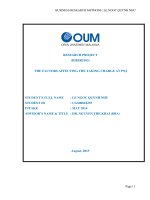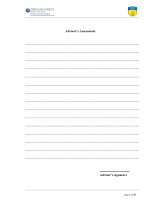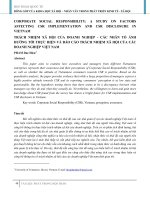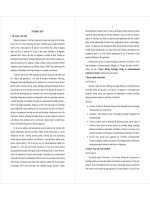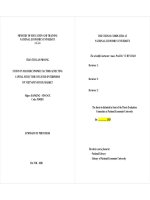FACTORS AFFECTING MANUFACTURING EMPLOYEE PERFORMANCE AT SAMSUNG ELECTRONICS VIETNAM
Bạn đang xem bản rút gọn của tài liệu. Xem và tải ngay bản đầy đủ của tài liệu tại đây (712.5 KB, 100 trang )
1
NATIONAL ECONOMICS UNIVERSITY
NEU BUSINESS SCHOOL
NGUYEN VAN TUYEN
FACTORS AFFECTING MANUFACTURING
EMPLOYEE PERFORMANCE AT SAMSUNG
ELECTRONICS VIETNAM
MASTER OF BUSINESS ADMINISTRATION THESIS
HANOI – 2020
NATIONAL ECONOMICS UNIVERSITY
NEU BUSINESS SCHOOL
NGUYEN VAN TUYEN
FACTORS AFFECTING MANUFACTURING
EMPLOYEE PERFORMANCE AT SAMSUNG
ELECTRONICS VIETNAM
MASTER OF BUSINESS ADMINISTRATION THESIS
SUPERVISOR: ASSOC. PROF. DR. VU THI MINH
HANOI – 2020
ACKNOWLEDGEMENT
First, I would very much like to express my warm gratitude to my thesis
supervisors, Associate Professor Doctor Vu Thi Minh, who instructed and taught me
a lot, gave me her valuable time and preciuos comments to contribute much to my
thesis. I would also like to extend my appreciation to all instructors at NEU
Business School for sharing their knowledge and experience with me.
Second, I send my sincere thanks to managers and colleagues at Samsung
Electronics Vietnam for catering me in collecting full and accurate data in research
process.
Finally, I also would like to thank my family and friends for their support in
finishing this thesis.
Thank you very much
Nguyen Van Tuyen
Nov 2020
TABLE OF CONTENTS
ABBREVIATION
SEV:
Samsung Electronics Vietnam
SEC:
Samsung Electronics Company
HRM:
Human Resource Management
EFA:
Exploration Factor Analysis
KPI:
Key Performance Indicator
MBO:
Management by Objectives
LIST OF TABLES
LIST OF FIGURES
Figure 1.1: Research process...................................................................................16
Figure 2.1: Research Model of the factors affecting manufacturing employee
performance at SEV...............................................................................28
Figure 3.1: Samsung Electronics Vietnam Organizational Chart.............................33
Figure 3.2: Age group..............................................................................................34
Figure 3.3: Gender structure....................................................................................34
Figure 3.4: Marital status.........................................................................................34
Figure 3.5: Workmanship level................................................................................35
Figure 3.6: Working time.........................................................................................35
Figure 3.7: Job position...........................................................................................36
Figure 3.8: Manufacturing employee’s performance evaluation result....................38
Figure 3.9: Manufacturing employee’s opinion about Working Space....................50
Figure 3.10: Manufacturing employee’s opinion about Infrastructure.....................50
Figure 3.11: Manufacturing employee’s opinion about working tools safety..........50
Figure 3.12: Manufacturing employee’s opinion about interpersonal relationship. .51
Figure 3.13: Manufacturing employee’s opinion about work interaction................51
Figure 3.14: Manufacturing employee’s opinion about Coaching...........................53
Figure 3.15: Manufacturing employee’s opinion about Empowerment...................53
Figure 3.16: Manufacturing employee’s opinion about Participation......................53
Figure 3.17: Manufacturing employee’s opinion about the Salary..........................56
Figure 3.18: Manufacturing employee’s opinion about the total Promotion............57
Figure 3.19: Manufacturing employee’s opinion about the Reward........................57
Figure 3.20: Manufacturing employee’s opinion about the Profit sharing...............58
Figure 3.21: Manufacturing employee’s opinion about the Job enrichment............58
Figure 3.22: Manufacturing employee’s opinion about the Recognition.................58
Figure 3.23: Manufacturing employee’s opinion about promotion opportunities....60
Figure 3.24: Manufacturing employee’s opinion about Creative & Innovation.......60
Figure 3.25: Manufacturing employee’s opinion about employee orientation.........61
Figure 3.26: Manufacturing employee’s opinion about Training Need Assessment 62
Figure 3.27: Manufacturing employee’s opinion about Training program & Method....64
Figure 3.28: Manufacturing employee’s opinion about On Job Training.................64
EXECUTIVE SUMMARY
Recently, almost of comapanys are fully understanded of the importance of
employee performance, especially in the field of smartphone manufacturing.
Improving employee performance or to find out the methods through which high
level of employee performance can be achieved is becoming one of the decisive
factors for any company success.
This research aimed to identify and measure the level of factors affecting the
manufacturing employee performance working at SEV, through identifying the
variables include leadership, organizational culture, working environment,
motivation, training & development. In the thesis, the author has used theory of
Khan and Jabbar (2013); Mathis & Jackson (2009) as the basis component
framework to measure the employee performance at SEV. These 05 factors are
measured by 20 obseved variables. Manufacturing employee performance is a
depedent variable which mesured by 04 observed variables .This study is qualitative
and quantitative in nature and aimed to find out the relationship between above
mentioned variables and manufacturing employee performance in SEV.
For this purposes data was collected from SEV with the research sample
consisted of 350 manufacturing employees are working in main assembly factory at
SEV. However, in the fact that, it is 326 of the manufacturing employee participated
in the survey, acounts for 93.14%. Questionnaires were collected by company email
system. Survey results were processed by SPSS software.
The mean of the manufacturing employee performance is 3.4 that mean
employee performance was average good level. Manufacturing employee have not
achieved maximum performance. The most inportance factors that affecting
manufacturing employee performance is Working Environment (Beta=0.319,
contributes 25.2 %), second by Leadership (Beta=0.313, contributes 24.72 %), and
Motivation (Beta=0.248, contributes 19.59 %). The problems in enhancing the
manufacturing employee at SEV are found as below:
- First, the employees think that there is a difference in their income between
shiftwork and group work while the base salary is the same. Employees work in
groups have higher income and working time is 4 days/week. Many employees
want to work in groups instead of working shifts. In fact, 31% of employees are
satisfied with total income (salary, benefits and other bonuses) and 38% “Neutral”
while 32% of employees are dissatisfied with total income.
- Second, promotion policy doesn’t have a clear for individual manufacturing
employee. Manufacturing employee is only promoted by job level and is rarely
appointed to direct management positions such as Sub / Line Leader. Ratings and
rewards are often awarded representing the whole production line or team.
Individual awards are limited. Only 33% of the employee while 37% didn’t satisfy
with promotion opportunities and rewarding.
Thirth, the mean of “You are satisfied with the support of leaders and colleagues
at work (WE5)” is only 3.01 which means that the employee didn’t satisfy with the
support of leaders and colleagues at work. In fact, 30% of the employee satisfied, 48%
neutral while 28% didn’t satisfy (20% Disagree and 8% Strongly Disagree).
Finally, the mean of "Leaders usually trust and encourages the members
decide on work methods (LS2)" is 3.22. This is normal level which means that
employees need to get more trust from Leaders and employees need more
encourage at work. The researcher gave some solutions to improve the
manufacturing employee performance as follow:
- Improving promotion & reward motivation: the company should build clear
criteria for promotion for manufacturing employee and career level.
- Improving the support of leaders and colleagues at work: Enhancing
coaching job skill, enhance discussion, work communication and building trust. In
addition, SEV also arranges employee rotation to suit their capacity and job
requirements.
Rearcher hoped that manufacturing employee performanace is improved and
help to enhance company performance and the company can develop sustainably.
CHAPTER 1: INTRODUCTION
1.1. Rationale
Employees are the human capital of organizations and their performance is a
key indicator for organization to achieve its goals. Recently, most of organizations
are fully aware of the importance of employee performance, increasing employee
performance is becoming one of the decisive factors for any organization success.
Therefore, it is very important to have capable employees who can account on them
to create competitive advantage.
Samsung Electronics Co., Ltd. (SEC) is the subsidiary of South Korea's
Samsung Group and the largest electronics producer in Asia. Samsung Electronics
operates four main divisions including Digital Media, Semiconductors, Information
& Communications, and Home Appliances. In mobile division, Samsung
Electronics Company (SEC) has 9 mobile phone factories globally. Include two
factories in Vietnam are SEV (Bac Ninh) and SEVT (Thai Nguyen). Currently,
these are the two largest and most modern Samsung Electronics mobile phone
components and assembling factories in the world.
Samsung Electronics Vietnam Co., Ltd. (SEV) in Yen Phong I Industrial
Park, Yen Trung commune, Yen Phong district, Bac Ninh province was granted
investment license on March 25, 2008. The total investment capital is 2.5 billion
USD. Currently, SEV has about 28,000 employees for manufacturing mobile phone
components for domestic assembly as well as exports to other factories.
Samsung's mobile phone business is currently facing fierce competition from
smartphone manufacturers such as Apple, Huawei, Vivo, Oppo, Xiaomi, etc. The
mobile market is gradually becoming saturated. This requires manufacturers to
constantly refresh themselves before being eliminated.
Vietnam is one of key markets for Samsung Electronics. In addition to the
competition in the phone market, the competition for human resources is also
extremely difficult. Samsung Electronics Vietnam has to come under increasing
pressure to improve their performance because the local labor force does not have
much working skills, skill level as well as disagreements in Korean and Vietnamese
languages. The value of factory performance audit in 02 recent years revealed a
number of weaknesses in performance management of production workers.
Performance disparities between production lines strong impact on product
output management and factory performance. Manufacturing employee also
complained about the management practices of some sub/line leaders.
The factory performance is only ranked 05th out of 09 Samsung
manufacturing mobile factory globally. Organizational performance refers to
employee performance. Samsung Electronics Vietnam (SEV) is also has to compete
performance with other Samsung mobile phone factories globally. The problem of
coporation management is how to manage high employee performance to achieve
high organizational performance. Management is responsible in carrying out the
task of managing the company in the right way.
With the aim of developing Samsung Electronis Vietnam to become one of
the best performing companies in mobile phone factories, as well as become the
company with the best working environment in Vietnam, the board of management
is determined to improve the performmance of employees. To achieve this, it is
necessary to find out factors that affect employee performance and provide
appropriate measures to help employees achieve the best performance.
There have a lot of researches done into the factors that affect employee
performance made by various scholars, many factors have been considered. From
the results of these researches, factors have a different affecting in organizations
because of the differences in the form and characteristics of each company. For
example, an employee who works at a manufacturing factory is different from a
store saleman or a service employee. Currently, there are very few researches about
workforce at electronics factories in Vietnam in general and there is no research
about on factors affecting employee performance at Samsung Electronis Vietnam in
particular. Therefore, as a Human Resources staff member at Samsung Electronics
Vietnam in order to help management find out factors affecting performance and
methods to innovation factors to achieve performance highest, Author chooses the
research topic: “Factors affecting manufacturing employee performance at
Samsung Electronics Vietnam”.
1.2.
Research objectives
1.2.1. General objective of the study
This study aims to identify the main factors that positive / negative affecting
employee performance. Base on that, proposal suitable solutions to improve
manufacturing employee performance of the company.
1.2.2. Specific objectives of the study
-
To identify a theoretical framework of factors affecting performance for SEV's
-
manufacturing employees.
To clearly identify the factors that affecting manufacturing employee performance
-
at SEV.
To analyze the status of current factors and measure the affecting level of each
factor on manufacturing employee performance at SEV to find out positive /
-
negative affecting.
To give some recommendations to enhance manufacturing employee performance at
SEV in the coming years.
1.3.
Research questions
-
What is theoretical framework of factors affecting manufacturing employee
-
performance at SEV?
What are the current factors affecting manufacturing employee performance at
-
SEV? What are level positive / negative affecting of its?
What should SEV do to improve manufacturing employee performance?
1.4. Research approach and methodology
1.4.1. Research approach
The researcher is self-motivated and self-initiated to complete this research
project in relation to academic, organizational and personal perspective. Following
to reliable sources of gaining information throughbooks, journals, articles,
government records or previous research on the same topics, the researcher
developed a Research Framework for analysis of the five factors significantly
affecting the manufacturing employee performance as described below:
H1= Relationships between Leadership and Employee’s Performance.
H2= Effect of Organizational Culture on Employee’s Performance.
H3= Relationships between Working Environment and Employee’s
Performance.
H4= Effect of Motivation on Employee’s Performance.
H5= Relationships between Training & Development and Employees’
Performance
Relationships between Leadership and Employee’s Performance
1.4.1.1.
H1: There is a positive relationship between leadership and employees’
performance.
This study is about the leadership attitude that affects employee performance.
If the leaders coach, empower or enhance the employees’ participation to the job,
the employees are willing to work energetically. The performance of the employees
is raised positively if the control and attitude of leaders are interactive and
promoting, then the employees work in a betterment of the organization. If the
manager is unbiased towards employees, these organizations progress more than
others. It is necessary that manager is unbiased and treats every employee without
discrimination.
The effect of Organizational Culture on Employee’s Performance
1.4.1.2.
H2: There is a positive relationship between the organizational culture and
employees’ performance.
According to this study, the organizational culture has influences on
upgrading the employees’ performance. If the environment is pleasant and
comfortable to work, the employees are encouraged and motivated to work
effectively and efficiently. The good and competitive organization culture enhances
the performance of the work force. The organizational culture that the employee
canfeel “like home” will support them to work dedicatedly. The members of the
organizations are encouraged to work effectively if the organizational culture
encourages to working effectively, is strong and motivating. Organizational culture
is a reflection of employees’ performance. It is directly proportional to the
employees’ performance.
1.4.1.3. Relationships between Working Environment and Employee’s Performance
H3: There is a positive relationship between the working environment and
employees’ performance.
The working environment (including physicaland behavioral components)
depending on the administrative, management, individuals and interaction patterns
between their philosophy. It is a set of characteristics that distinguish the
organization from others and the characteristics of the organization’s internal
environment results from the interaction outcome of goals, regulations, rules,
procedures and policies that are applied in the organization and well known by the
employees in the organization. More over directly and indirectly affects the
individual behavior and performance at work eventually leads to achieve the goals
of the organization.
The effect of Motivation on Employee’s Performance
1.4.1.4.
H4: There is a positive relationship between motivation and employees’
performance
It is very important to motivate employees for increasing their performance.
In an organization where employees are valued for their knowledge, qualification
and skills, the best employee motivation efforts focus on what employees deem to
be important. Employee motivation become a crucial factor to increase employees’
longevity, productivity, better moral, better performance and create better
organization performance. Pay, rewards, profit sharing, promotion, recognition, job
enrichment, decisionalparticipation, authority, health insurance etc… All these
factors can motivate employees’ and increase their performance.
Relationships between Training and Employees’ Performance
1.4.1.5.
H5: There is a positive relationship between training and employees’
performance.
There is a strong relationship between training and employee performance.
As the means of training is giving new or current employees the skills they need to
perform at their various jobs (Dessler, 2008) or to help them acquire competencies for
the job completion, in correlations of employees’ performance, training will increase
employees’ ability to perform on the job in a better way. In addition, training is
supposed to be a non-financial motivator to reward employees for their good
performance.
1.4.2. Research methodology
Reseacher process
1.4.2.1.
The research conducts with the following process
Identify
Identify Problem,
Problem, Objectives
Objectives
Select
Select theotical
theotical Framework
Framework
Build
Build scales
scales of
of manufacturing
manufacturing employee’s
employee’s
performance
performance
Questionnaire
Questionnaire
Cronbach
Cronbach alpha
alpha
Exploratory
Exploratory factor
factor analysis
analysis (EFA)
(EFA)
Adjust
Adjust the
the scales
scales of
of manufacturing
manufacturing
employee's
employee's performance
performance
Regression
Regression analysis
analysis
Analyze
Analyze current
current manufacturing
manufacturing employee’s
employee’s performance
performance at
at
SEV
SEV and
and main
main affecting
affecting factors
factors
Some
Some solutions
solutions to
to improve
improve manufacturing
manufacturing employee’s
employee’s performance
performance at
at SEV
SEV
(Source: author design)
Figure 1.1: Research process
1.4.3. Data collection
The data is collected from two sources: secondary data and primary data.
Secondary data is collected from:
-
Textbooks, journals, magazines and newspapers, publish researches, internet, etc.
-
Relevant documents, reports from SEV from 2017-2020.
Primary data is collected by:
+ Questionnaire:
The population for this study comprised all manufacturing employee in main
assembling area with the population are approximately 350. Accordingly, there are
350 questionnaires are delivered in paper and online survey method. There are 326
manufacturing employee participated in the survey for a perticipation rate 93.14 %.
Survey questionnaire contains the following two sections:
- Section 1: Respondents are requested to give general information (age, gender…).
- Section 2: The questions are designed to be clear and easy to understand. The
questionnaires include items to measure the different variables of the research
model to study the impact of leadership, organizational culture, working
environment, motivation and training & development on employee performance.
The respondents are expected to provide necessary information according to
the designed questionnaire consisted of the followings matters:
I. Leadership (including 03 sub-items)
II. Organizational culture (including 03 sub-items)
III. Working environment (including 05 sub-items)
IV. Training & Development (including 03 sub-items)
V. Motivation (including 06 sub-items)
VI. Performance (including 04 sub-items)
The questionnaire is included a total of 24 questions and was designed on
Likert Scale type from 1 to 5 such as strongly disagree, disagree, neutral, agree, and
strongly agree. Respondents answer the givenquestions by marking the correct and
suitable choice. The questionnaire is in bilingual (English and Vietnamese) for the
best comprehension and interpretation. Furthermore, respondents need to
supplement other related information including gender, age group, level of
education and job position.
+ From observation: The author has been working for SEV more than 5
years. Thus, I have witnessed its development and changing. I have chance to work
with manufacturing employees and understand about working’s quality and
effectiveness.
+ In-dept interview: Carried out in-depth interview with 20 peoples.
1.4.4. Data analysis
The study used qualitative methods to preliminarily study the factors
affecting manufacturing employee performance in Samsung Electronics Vietnam.
This study used quantitative methods through Cronbach's alpha analysis to
test the scale, factor analysis to group and type of the variable. And finally, the
study uses regression analysis to examine the level of importance of each scale to
enhance performance. SPSS software is used to analysis the data.
1.5.
Research scope
This research focuses on the five factors affecting on manufacturing
employee performance at Samsung Electronics Vietnam:
-
Location: This research collects and analyzes data from SEV’s employee.
In the research, firm’s document is used for the period of 2017-2020
1.6.
Thesis Structure outline
The thesis includes 04 chapters:
Chapter 1: Introduction
Chapter 2: Theoretical background
on
manufacturing
employee’s
performance
Chapter 3: Current manufacturing employee’s performance at SEV
Chapter 4: Some solutions for SEV to enhancing manufacturing employee’s
performance at SEV.
CHAPTER 2: THEORETICAL BACKGROUND ON
MANUFACTURING EMPLOYEE PERFORMANCE
2.1.
Definition of Employee Performance
Performance can be defined very simply as behaviors that lead to results or
purposeful work. Sonnentag.et. al. (2008) said that employee performance as the
outcome aspect in turn refers to the result of the individual’s behavior.
Khan and Jabbar (2013) defined employee performance means employee
productivity and efficiency as a result of employee growth. It means the specific
outcomes a person wants to achieve in his job and because the organization wants to
achieve that outcome.
Aguinis (2009) described that “the definition of performance does not only
include the results of an employee’s behavior, but all behaviors themselves.
Performance is about behavior or what employees do, not only is about what
employees produce or the outcomes of their work”. Perceived employee
performance represents the general belief of the employee about his behavior and
contributions in the success of organization.
Mathis & Jackson (2009) employee performance assesses whether a person
performs a job well. It is affected by different factors at workplace. Employee
performance indicates the effectiveness of employee’s specific actions that
contribute to attaining organizational goals. Performance is associated with quantity
of output, quality of output, the timeliness of output, presence / attendance on the
job, efficiency of the work completed and effectiveness of work completed”
In summary, this thesis uses the definition by Khan and Jabbar (2013);
Mathis & Jackson (2009). This definition has four key indicators reflect of
performance: employee productivity, efficiency, effectiveness, and timeliness.
The productivity element is a measure of intensity, behavior, and
contributions. The effectiveness of employee’s specific actions that contribute to
attaining organizational goals.
2.2.
The importance of improving manufacturing employee performance in
manufacturing operation
- Employees are the human capital of organizations and their performance is
a key indicator for organization to achieve its goals. Employee performance is one
of the most important constructs in both organizational psychology and human
resource management (Campbell, McHenry, & Wise, 1990).
- Employees usually represent the largest expense for a company, and
measuring performance is essential to the employee management process.
- Improving manufacturing employee performance help to enhance the
competitive advantage and therefore the organization’s performance increase.
- Good manufacturing employee performance helps to lowers employee
expense.
- According to Collis and Montgomery (1995) employees play an important
role in organizational success. Employees’ performance has a positive relationship
with organization performance.
- Manufacturing employee performance shows that job satisfaction.
- Manufacturing employee performance can also relate to how efficiently a
company uses economic resources. Economic resources include the direct materials
and facilities needed to produce products. Poor manufacturing employee
performance can result in wasted resources and higher business operating costs
- Manufacturing employee performance also impacts company culture. If
your employees are engaged, punctual, managed fairly and willing to take
responsibility that creates a culture of respect and trust. That leads to employees
staying with your business longer.
That means a good performance workforce means a highly productive staff,
all of which will help you achieve your business goals.
2.3.
The nature of employees in manufacturing operation
Employees in manufacturing factory are responsible for mass production of a
specific product in a manufacturing or production facility. Depending on the
position and company, a production worker's duties may vary from office, operating
machinery, assembling materials or equipment, carrying out inspections and quality
control or include a managerial or supervisory role.
In mobile phone manufacturing, desirable skills include being reliable,
individual skill and diligent with the ability to work efficiently while maintaining
high standards in quality at all times. Due to the nature of the work, production
employees must be able to stand or sitfor long hours at a time, perform repetitive
tasks with minimal supervision. A flexibles work schedule with the ability to work
shifts, overtime and weekend.
2.4.
Factors affecting employee performance theories
There have been a lot of researches done on employee performance by many
scholars, many factors affecting employee performance were considered. It is clear
that no standard factor is applicable to all organizations because of individual
differences. Most of researches explored employee performance in the foreign
countries. In Vietnam, most of employee performance researches focused on other
industries such as services, sale, bank, and government agencies. Until present,
knowledge about employee performace of hight technology manufacturing in
Vietnam is still limited. These research findings about employee performance in
other countries, other industries and other organizations are not sure to be valid for
the mobile phone manufacturing of Samsung Electronics Vietnam because of the
difference between industries, organizations and individual differences. So, this
study will be steered mainly certain factors individually and collectively effect on
the performance of employees in a positive or negative way, including:
2.4.1.
Leadership
Armstrong & Murlis (2004); Cronje et al (2001) together indicated that the
leadership stylewithin an organization has a bearing on encouraging or inhibiting
employee’s performance. Northouse (2007) defined that leadership is a process
whereby an individual influences a group of individuals to achieve common goals.
In a longitudinal study, Mosadegh & Yarmohammadian (2006) indicated that good
and effective leaders matter to the overall performance and well-being of the
organization and its members. In a survey, Keller (2006) discovered that employees
will give their best if leader have good expectations from them. If people feel that
leaders are not appreciating them for their good performance, then they will feel de
motivated. If a leader is not giving feedback on a good performance, it will create a
communication gap and ultimately the employee will feel overlooked and his
performance will be declining.
2.4.1.1. Coaching
Coaching based Leadership is used to improve employees’ performances
and professional roles (Goldsmith & Lyons, 2006; Moen, 2010; Underhill, et al.,
2007). When a coachee is faced with an exploration of the potential for
enhancing performances, the coach and the coachee begin with pursuing learning
goals (Gallwey, 2000; Moen & Kvalsund, 2008; Passmore & Gibbes, 2007;
Wilson, 2007).
Champathes (2006) identified coaching has become an important technique
to improve performance. It is not a oneway communication and proves to be a two
way communications where coaches identify what can be improved and how it can
be improved. Jarvis (2014) explains that there is an increasing trend in today’s
organisations in recognizing developmental need of the employees, help in personal
problem solving and planning of activities to be undertaken by the employee.
Research has found that employee’s job performance is a function of their abilityb
and chance to organize their ideas, knowledge and abilities in an effective way. The
results of a survey (Jarvis, 2014) also indicated coaching can help in enhancing an
employee performance as it provides the employee with a chance to increase their
skills and motivation which eventually leads to an overall positive impact on the
employee job performance. Further, coaching also addresses the belief and
behaviors that hinder performance (Toit, 2007). Starr (2004) also agreed further
seen that coaching is all about helping someone else to improve performance.
2.4.1.2.
Empowerment
Empowerment of leadership has been seen as a distinct type of leader
behaviour (Arnold et al., 2000), providing support to subordinates through
coaching, encouragement, training and emotional support, and information
(Bandura, 1986). Employees are thus more likely to have a sense of meaning in
their jobs, and to feel capable of implementing job activities on a self‐managed
basis.
The Study of Ronah (2015) concluded that empowerment as a well-known
managerial concept, empowerment of employees plays a potential role in promoting
organizational performance. Duvall (1999) defines success as achievement,
accomplishment and attainment which is consequence of empowerment as follows:
(1) Individual success in form of employee’s role performance, (2) Organizational
success which is achieved as members of the organization accomplish collective
organizational goals and objectives, and (3) As organizational members share a
mutually beneficial and satisfying work experience meeting both social and
personal growth needs. Further, empowerment had significant positive correlations
with both performance and satisfaction (Bartram and Casimir, 2007).
According to the research done by Towers Watson in 2010, a majority of
manager believe that talent retention will be more difficult in next years whereby
they will need a deeper reason to stay in the organization. They will need to feel
they are appreciated for their contributions, have the resources to do their jobs to the
best of their abilities, and have clearly defined opportunities to develop and advance
within the organization. In short, they must be empowered beyond being asked to
meet performance goals. Empowerment plays significant role in employee’s
satisfaction thus promoting their performance in organizations. Empowerment is
also defined as the process of enabling and authorizing individuals to think,
behaves, take action and decision and control work autonomously. Menon (2001)
surveyed 311 employees in a company, he found that the greater the empowerment
the greater was the motivation to work among employees, which led to less job
stress and increased employee commitment to organizational goals.
2.4.1.3. Participation
In 1967, Rensis Likert and his colleagues identified the foundation for
leadership theories. After more than 30 years of research, the participation is one
factor of leadership styles, which were eventually formulated.
Participation is characterised by the leader actively involving team members
in identifying objectives, developing strategy, and decision-making in general.
In Chen and Tjosvold research 2006, they defined that participation
management is about involving employees in the decision making process
where the employees feel that they have the opportunity to discuss problems
and can influence organizational decisions. The overall impact of participation
is increased employee job performance and low turn- over. In addition,
organizations can act to increase or decrease the levels of these mediator
variables within their personals and potentially strengthen the positive
performance effects of employee participation (Lam et al, 2002). According to
Carrel, Kuzmits & Elbert (1989) Employee will be motivated because
management considers them as partners in contributing to organizational
success instead of being seen as mere subordinates and therefore will avoid
engaging into counterproductive behaviors hence improved performance
through timely achievement of organizational goals and objectives.
2.4.2.
Organization Culure
According to Schein (1990) organizational culture is common values and
behaviors of the people that considered as a tool leads to the successful achievement
of organization goals. Deal and Kennedy (1982) candidated that strong culture in
the organization is very helpful to enhance the performance of the employees that
leads to the goal achievement and increase the overall performance of the
organization. According to the Stewart (2010), norms and values of organizational
culture highly effect on those who are directly or indirectly involved with the
organization. These norms are invisible but have a great impact on the performance
of employees and profitability.
Daft (1984) dicovered that a strong organizational culture supports
adaptation and develops organization’s employee performance by motivating
employees toward a shared goal; and finally shaping and channeling employees’
behavior to that specific direction should be at the top of operational and functional
strategies. Schein (1994) clarifies that value which is a set of social norms that
define the rules or framework for social interaction and communication behaviors
of society’s members, is a reflection of causal culture assumptions. Peters and
Waterman (1982) and practitioners argue that the performance of an organization is
dependent on the degree to which the values of the culture are widely shared.
Similarly, Ogbonna (1993) widely argued that shared and strongly held values
enable management to predict employee reactions to certain strategic options and
by reducing these values, the consequences maybe undesirable.
2.4.3.
Working Environment
Janssen, O. & NW. Van Yperen (2004) identified the influence degree of
working environment is the counterpart requirement of a creative job. Higher job
satisfaction and lower intentions to leave were found for those individuals whose
work environment accompanied the creative requirements of jobs. The workplace
atmosphere includes both physical and psychological factors due to which
performance enhance. The environment plays an important role to enhance
performance. It also increases the job satisfaction. According to Brenner (2004) to
ensure more output the infrastructure is well planned with worker contentment.
Opperman (2002) argued that infrastructure is the combination of three important
atmospheres that is managerial atmosphere, scientific atmosphere and individual
atmosphere. Scientific atmosphere consists of apparatus, utensils and all other
scientific factors. So, workers perform their tasks effectively. The individual
atmosphere consists of subordinates, executives all other staff of the organizations.
The individual atmosphere is builds in such a way in which communication level is
enhanced between employees to ensure more output. Managerial atmosphere


